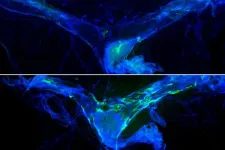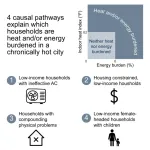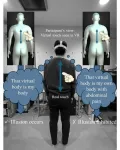(Press-News.org) As aging bodies decline, the brain loses the ability to cleanse itself of waste, a scenario that scientists think could be contributing to neurodegenerative conditions such as Alzheimer’s disease and Parkinson’s disease, among others. Now, researchers at Washington University School of Medicine in St. Louis report they have found a way around that problem by targeting the network of vessels that drain waste from the brain. Rejuvenating those vessels, they have shown, improves memory in old mice.
The study, published online March 21 in the journal Cell, lays the groundwork to develop therapies for age-related cognitive decline that overcome the challenges faced by conventional medications that struggle to pass through the blood-brain barrier to reach the brain.
“The physical blood-brain barrier hinders the efficacy of therapies for neurological disorders,” said Jonathan Kipnis, PhD, the Alan A. and Edith L. Wolff Distinguished Professor of Pathology & Immunology and a BJC Investigator at WashU Medicine. “By targeting a network of vessels outside of the brain that is critical for brain health, we see cognitive improvements in mice, opening a window to develop more powerful therapies to prevent or delay cognitive decline.”
Waste removal improves memory
Kipnis is an expert in the blossoming field of neuroimmunology, the study of how the immune system affects the brain in health and disease. A decade ago, Kipnis’ lab discovered a network of vessels surrounding the brain — known as the meningeal lymphatics — in mice and humans that drains fluid and waste into the lymph nodes, where many immune system cells reside and monitor for signs of infection, disease or injury. He and colleagues also have shown that some investigational Alzheimer’s therapies are more effective in mice when paired with a treatment that improves drainage of fluid and debris from the brain.
Beginning at about age 50, people start to experience a decline in brain fluid flow as part of normal aging. For the new study, Kipnis collaborated with Marco Colonna, MD, the Robert Rock Belliveau, MD, Professor of Pathology, and asked if enhancing the function of an old drainage system can improve memory.
To test the memory of mice, the researchers placed two identical black rods in the cage for twenty minutes for old mice to explore. The next day, the mice received one of the black rods again and a new object, a silver rectangular prism. Mice that remember playing with the black rod will spend more time with the new object. But old mice spend a similar amount of time playing with both objects.
The first author of the new study, Kyungdeok Kim, PhD, a postdoctoral fellow in the Kipnis lab, boosted functioning of the lymphatic vessels in old mice with a treatment that stimulates vessel growth, enabling more waste to drain out of the brain. He found that the older mice with rejuvenated lymphatic vessels spent more time with the new object – an indicator of improved memory – compared with the older mice not given the treatment.
“A functioning lymphatic system is critical for brain health and memory,” said Kim. “Therapies that support the health of the body’s waste management system may have health benefits for a naturally aging brain.”
Brain’s overwhelmed cleaning crew
When the lymphatic system is so impaired that waste builds up in the brain, the burden of cleaning falls to the brain’s resident immune cells, called microglia. But this local cleaning crew fails to keep up with the mess and gets exhausted, Kipnis explained.
The new study found that the overwhelmed cells produce a distress signal, an immune protein called interleukin 6, or IL-6, that acts on brain cells to promote cognitive decline in mice with damaged lymphatic vessels. Examining the brains of such mice, the researchers found that neurons had an imbalance in the types of signals they receive from surrounding brain cells. In particular, neurons received fewer signals that function like noise-canceling headphones among the cacophony of neuron communications. This imbalance, caused by increased IL-6 levels in the brain, led to changes in how the brain is wired and affected proper brain function.
In addition to improving memory in the aged mice, the lymphatic vessel-boosting treatment also caused levels of IL-6 to drop, restoring the noise-canceling system of the brain. The findings point to the potential of improving the health of the brain’s lymphatic vessels to preserve or restore cognitive abilities.
“As we mark the 10th anniversary of our discovery of the brain’s lymphatic system, these new findings provide insight into the importance of this system for brain health,” said Kipnis. “Targeting the more easily accessible lymphatic vessels that are located outside the brain may prove to be an exciting new frontier in the treatment of brain disorders. We may not be able to revive neurons, but we may be able to ensure their most optimal functioning through modulation of meningeal lymphatic vessels.”
Kim K, Abramishvili D, Du S, Papadopoulos Z, Cao J, Herz J, Smirnov I, Thomas JL, Colonna M, Kipnis J. Meningeal lymphatics-microglia axis regulates synaptic physiology. Cell. March 21, 2025.
This work was supported by the National Institute on Aging of the National Institutes of Health (NIH), grant numbers AG034113 and AG078106; the BJC investigator’s program at Washington University in St. Louis; the Neuroscience Innovation Foundation; and the National Research Foundation of Korea, grant number 2021R1A6A3A14045044. The content is solely the responsibility of the authors and does not necessarily represent the official views of the NIH.
Jonathan Kipnis is a co-founder of Rho Bio and holds patents and provisional applications related to the work presented here.
About Washington University School of Medicine
WashU Medicine is a global leader in academic medicine, including biomedical research, patient care and educational programs with 2,900 faculty. Its National Institutes of Health (NIH) research funding portfolio is the second largest among U.S. medical schools and has grown 56% in the last seven years. Together with institutional investment, WashU Medicine commits well over $1 billion annually to basic and clinical research innovation and training. Its faculty practice is consistently within the top five in the country, with more than 1,900 faculty physicians practicing at 130 locations and who are also the medical staffs of Barnes-Jewish and St. Louis Children’s hospitals of BJC HealthCare. WashU Medicine has a storied history in MD/PhD training, recently dedicated $100 million to scholarships and curriculum renewal for its medical students, and is home to top-notch training programs in every medical subspecialty as well as physical therapy, occupational therapy, and audiology and communications sciences.
END
Boosting brain’s waste removal system improves memory in old mice
Research opens door to developing therapies for neurodegenerative diseases
2025-03-21
ELSE PRESS RELEASES FROM THIS DATE:
New study sheds light on risks from residential heat and energy burdens in Miami
2025-03-21
A new study on indoor extreme heat connects these two burdens to reveal how the co-occurrence of escalating energy bills and dangerously hot homes in Miami-Dade County exacerbates health and well-being risks for vulnerable households across months of the year.
“Our findings help us understand which types of households are struggling with high indoor heat and high energy bills in a place like Miami, which is hot for many months of the year,” said Lynée Turek-Hankins, the lead author of the study that was conducted during her doctoral studies at the University of Miami Rosenstiel School of Marine, Atmospheric, and Earth Science and the Abess Center for Ecosystem ...
Racial and ethnic inequalities in actual vs nearest delivery hospitals
2025-03-21
About The Study: This cohort study found that American Indian and Black individuals delivered at lower-quality hospitals than white individuals. The disparity in care between Black and white birthing individuals would have been reduced if individuals had delivered at their nearest hospital.
Corresponding Author: To contact the corresponding author, Nansi S. Boghossian, PhD, email nboghoss@email.sc.edu.
To access the embargoed study: Visit our For The Media website at this link https://media.jamanetwork.com/
(doi:10.1001/jamanetworkopen.2025.1404)
Editor’s ...
State earned income tax credits and firearm suicides
2025-03-21
About The Study: In this cohort study, the presence and generosity of state refundable earned income tax credits were associated with a decrease in firearm suicide rates, supporting the growing body of literature highlighting the importance of antipoverty policies for reducing firearm suicide.
Corresponding Author: To contact the corresponding author, Nicole Asa, MPH, email nasa3@uw.edu.
To access the embargoed study: Visit our For The Media website at this link https://media.jamanetwork.com/
(doi:10.1001/jamanetworkopen.2025.1398)
Editor’s Note: Please see the article for additional information, ...
VR study reveals how pain and fear weaken sense of body ownership
2025-03-21
A study from Hiroshima University found that when people were told to imagine their virtual bodies in pain, their brains resisted the illusion of ownership. Their findings could provide insights into why some people may struggle with feeling connected to their own bodies, particularly in contexts involving depersonalization or negative physical states.
The sense of body ownership—the feeling that our body belongs to us—is crucial in distinguishing ourselves from objects and responding to threats. Researchers study it using techniques like the rubber hand illusion (RHI) and full-body illusion (FBI), in which an individual is somehow ...
Quantum leap: Graphene unlocks orbital hybridization
2025-03-21
Peking University, March 19, 2025: A research team led by Professor Sun Qing-Feng in colloboration with Professor He Lin’s research group from Beijing Normal University has achieved orbital hybridization in graphene-based artificial atoms for the first time. Their findings, entitled “Orbital hybridization in graphene-based artificial atoms” was published in Nature (DOI: 10.1038/s41586-025-08620-z). This work marks a significant milestone in the field of quantum physics and materials science, bridging the gap between artificial and real atomic behaviors.
Why it matters:
1. Quantum dots, often called artificial atoms, can mimic atomic orbitals but have not yet ...
How black holes could nurture life
2025-03-21
At the center of most large galaxies, including our own Milky Way, sits a supermassive black hole. Interstellar gas periodically falls into the orbit of these bottomless pits, switching the black hole into active galactic nucleus (AGN)-mode, blasting high-energy radiation across the galaxy.
It's not an environment you'd expect a plant or animal to thrive in. But in a surprising new study in the Astrophysical Journal, researchers at Dartmouth and the University of Exeter show that AGN radiation can have a paradoxically nurturing effect on life. Rather ...
Dr. Amit Bar-Or, penn medicine neuroimmunologist, awarded the 2025 John Dystel prize for multiple sclerosis research
2025-03-21
Amit Bar-Or, MD, a distinguished researcher and neurologist at Penn Medicine, is the winner of the 2025 John Dystel Prize for Multiple Sclerosis Research, awarded jointly by the National Multiple Sclerosis Society and the American Academy of Neurology. He is being honored for advancing our knowledge of neuroimmunology, precision medicine, and biomarkers in MS. Dr. Bar-Or will deliver the Dystel Prize lecture and receive his award at the American Academy of Neurology 2025 Annual Meeting in San Diego, California on April 8, 2025.
“Dr. Bar-Or has been a key player in shaping the evolving conceptual framework of MS, including how the ...
Recent study in mice provides key insights on the impact of excessive sucrose consumption in specific organs
2025-03-21
Researchers at the Advanced Research Unit on Metabolism, Development & Aging (ARUMDA), in the Tata Institute of Fundamental Research (TIFR, Mumbai and TIFR Hyderabad), have unveiled a comprehensive understanding of the harmful effects of sugar-sweetened beverages (SSBs) on human health, using a preclinical mouse model that closely mimics human consumption patterns. The study, published in the Journal of Nutritional Biochemistry, sheds light on how chronic sucrose-water intake (10%) alters key physiological, molecular, and metabolic processes across various organs, driving ...
A less toxic way to manufacture daily goods
2025-03-21
Diisocyanates are used in the preparation of all polyurethanes, ranging from the foams used in shoe soles to the thermoplastics used in cell phone cases. Aromatic diisocyanates, which give polyurethane foams their structure, are commonly prepared on the megaton scale in highly secure facilities due to the use of phosgene, a highly reactive and toxic chemical reagent. Michael Burkart’s lab at UC San Diego recently reported the preparation of fully bio-based aromatic diisocyanates from a simple monosaccharide, D-galactose. This new route avoids the use of transition metals, gaseous reagents or any high-pressure/temperature reactions. As an application, the team demonstrates ...
Nearly half of depression diagnoses could be considered treatment-resistant
2025-03-21
Almost half of patients diagnosed with depression classify as being ‘treatment-resistant’ as new research suggests that many don’t respond to multiple antidepressant options.
The new study, published in the British Journal of Psychiatry was led by academics from the University of Birmingham and Birmingham and Solihull Mental Health NHS Foundation Trust. The study found that 48% of patients whose electronic healthcare records reported a diagnosis of depression had tried at least two antidepressants, and 37% had tried four or more different options.
Treatment-resistant depression (TRD) is ...
LAST 30 PRESS RELEASES:
When is it time to jump? The boiling frog problem of AI use in physics education
Twitter data reveals partisan divide in understanding why pollen season's getting worse
AI is quick but risky for updating old software
Revolutionizing biosecurity: new multi-omics framework to transform invasive species management
From ancient herb to modern medicine: new review unveils the multi-targeted healing potential of Borago officinalis
Building a global scientific community: Biological Diversity Journal announces dual recruitment of Editorial Board and Youth Editorial Board members
Microbes that break down antibiotics help protect ecosystems under drug pollution
Smart biochar that remembers pollutants offers a new way to clean water and recycle biomass
Rice genes matter more than domestication in shaping plant microbiomes
Ticking time bomb: Some farmers report as many as 70 tick encounters over a 6-month period
Turning garden and crop waste into plastics
Scientists discover ‘platypus galaxies’ in the early universe
Seeing thyroid cancer in a new light: when AI meets label-free imaging in the operating room
Neutrophil-to-lymphocyte ratio may aid risk stratification in depressive disorder
2026 Seismological Society of America Annual Meeting
AI-powered ECG analysis offers promising path for early detection of chronic obstructive pulmonary disease, says Mount Sinai researchers
GIMM uncovers flaws in lab-grown heart cells and paves the way for improved treatments
Cracking the evolutionary code of sleep
Medications could help the aging brain cope with surgery, memory impairment
Back pain linked to worse sleep years later in men over 65, according to study
CDC urges ‘shared decision-making’ on some childhood vaccines; many unclear about what that means
New research finds that an ‘equal treatment’ approach to economic opportunity advertising can backfire
Researchers create shape-shifting, self-navigating microparticles
Science army mobilizes to map US soil microbiome
Researchers develop new tools to turn grain crops into biosensors
Do supervised consumption sites bring increased crime? Study suggests that’s a myth
New mass spec innovation could transform research
Maternal nativity, race, and ethnicity and infant mortality in the US
Migration-related trauma among asylum seekers exposed to the migrant protection protocols
Jupiter’s moon Europa has a seafloor that may be quiet and lifeless
[Press-News.org] Boosting brain’s waste removal system improves memory in old miceResearch opens door to developing therapies for neurodegenerative diseases




